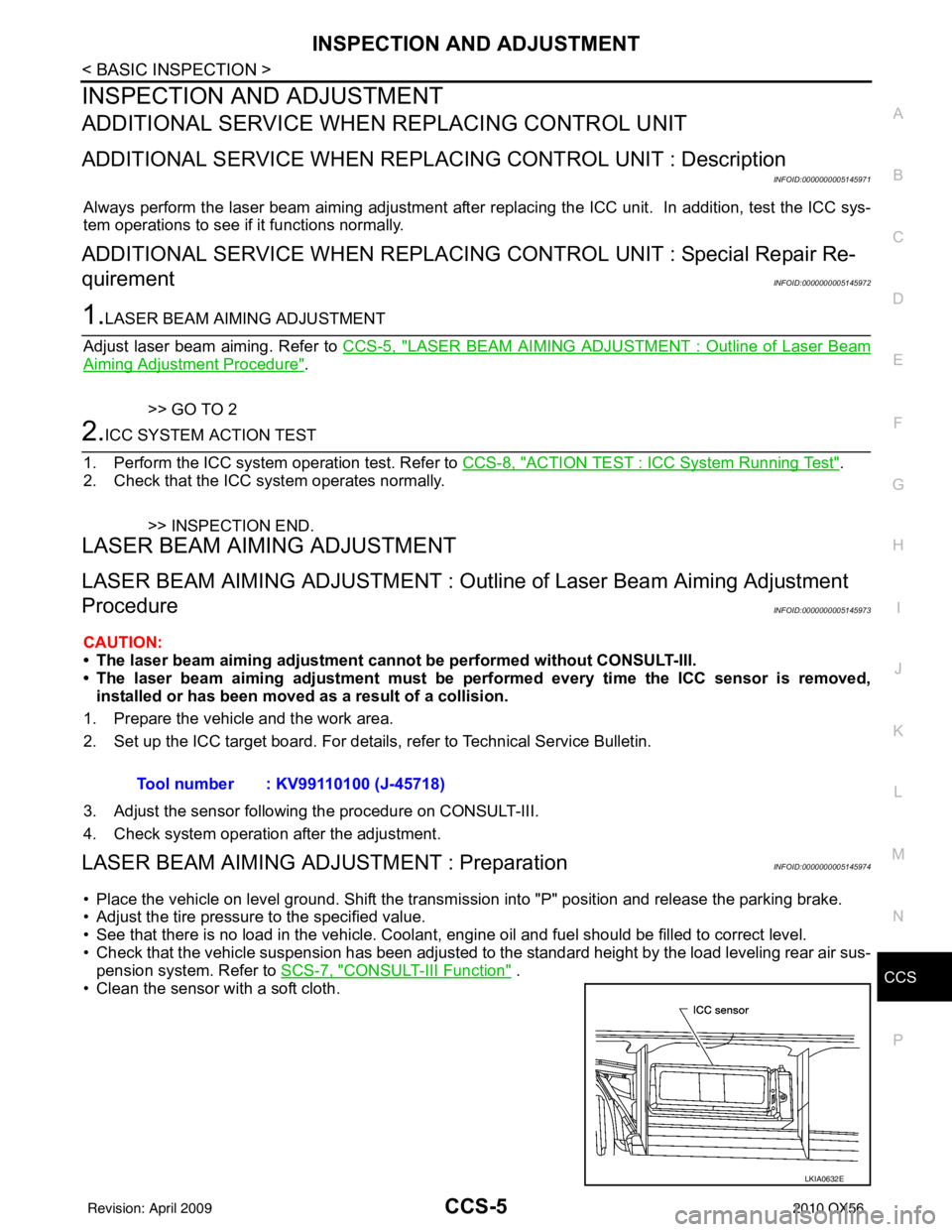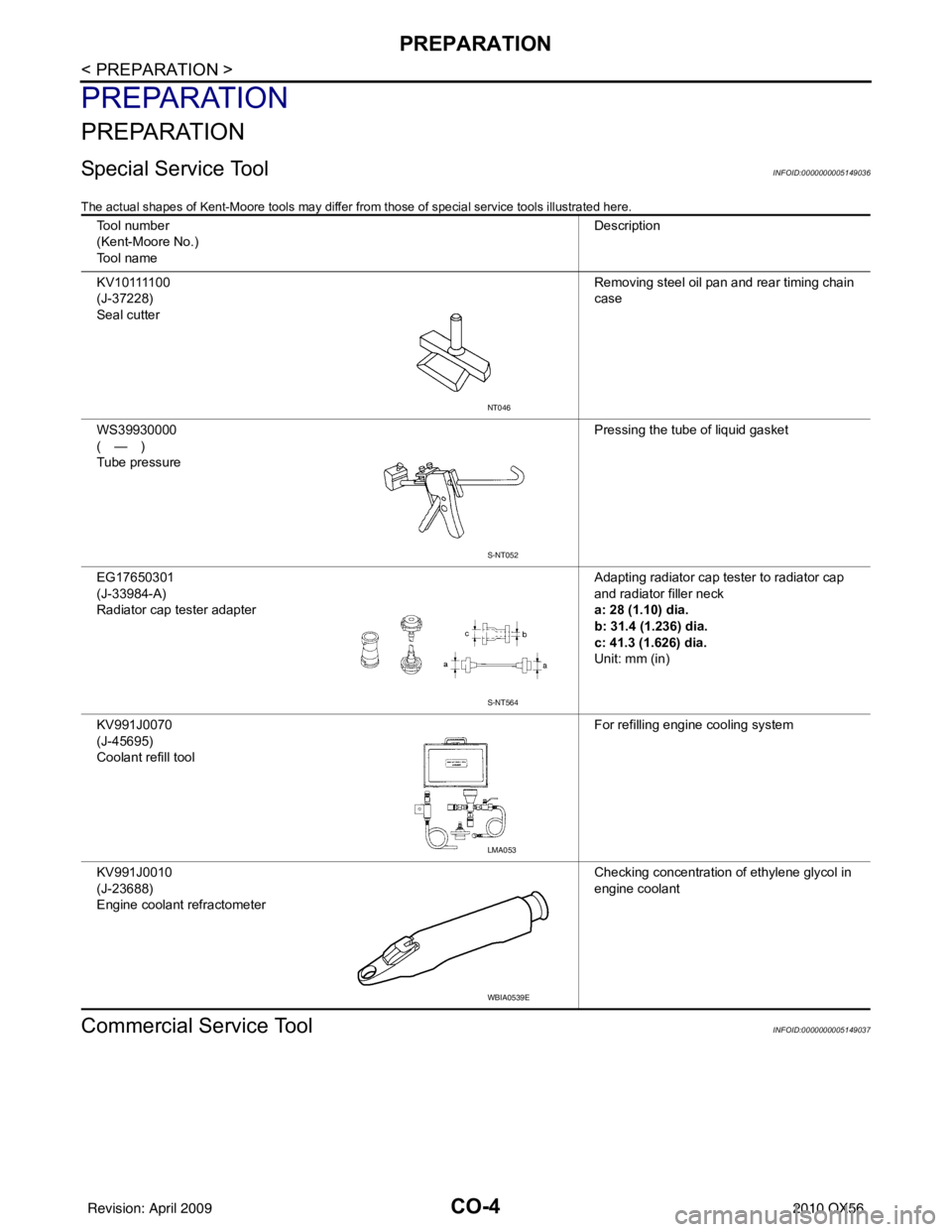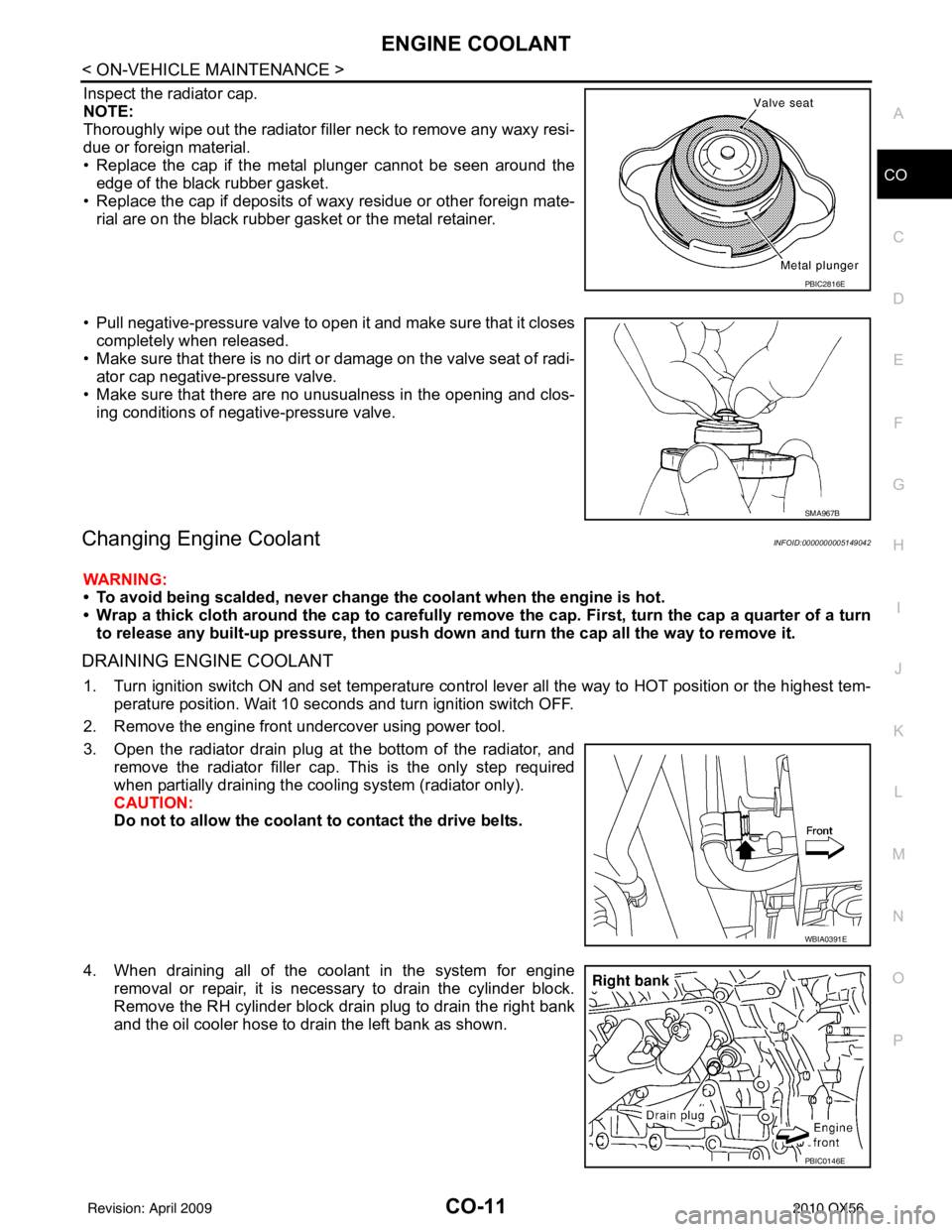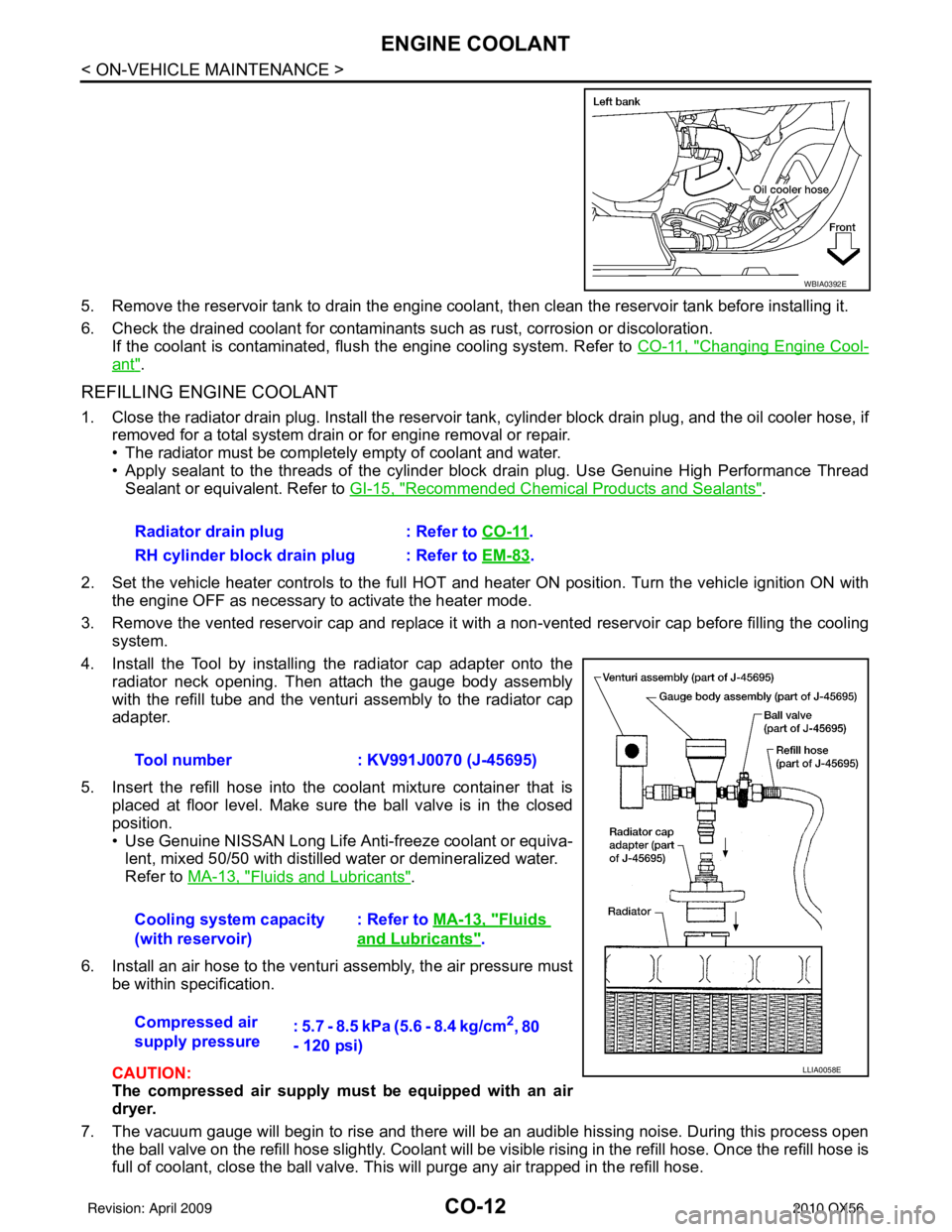oil pressure INFINITI QX56 2010 Factory Service Manual
[x] Cancel search | Manufacturer: INFINITI, Model Year: 2010, Model line: QX56, Model: INFINITI QX56 2010Pages: 4210, PDF Size: 81.91 MB
Page 398 of 4210
![INFINITI QX56 2010 Factory Service Manual BCS-12
< FUNCTION DIAGNOSIS >[BCM]
SIGNAL BUFFER SYSTEM
SIGNAL BUFFER SYSTEM
System DiagramINFOID:0000000005146389
System DescriptionINFOID:0000000005146390
OUTLINE
BCM has the signal transmission fun INFINITI QX56 2010 Factory Service Manual BCS-12
< FUNCTION DIAGNOSIS >[BCM]
SIGNAL BUFFER SYSTEM
SIGNAL BUFFER SYSTEM
System DiagramINFOID:0000000005146389
System DescriptionINFOID:0000000005146390
OUTLINE
BCM has the signal transmission fun](/img/42/57032/w960_57032-397.png)
BCS-12
< FUNCTION DIAGNOSIS >[BCM]
SIGNAL BUFFER SYSTEM
SIGNAL BUFFER SYSTEM
System DiagramINFOID:0000000005146389
System DescriptionINFOID:0000000005146390
OUTLINE
BCM has the signal transmission function that output
s/transmits each input/received signal to each unit.
Signal transmission function list
ALMIA0263GB
Signal nameInputOutputDescription
Oil pressure switch signal IPDM E/R (CAN) Combination meter (CAN)Transmits the received oil pres-
sure switch signal via CAN
communication.
Revision: April 20092010 QX56
Page 414 of 4210
![INFINITI QX56 2010 Factory Service Manual BCS-28
< FUNCTION DIAGNOSIS >[BCM]
DIAGNOSIS SYSTEM (BCM)
SIGNAL BUFFER : CONSULT-III Fu nction (BCM - SIGNAL BUFFER)
INFOID:0000000005146411
DATA MONITOR
ACTIVE TEST
AIR PRESSURE MONITOR
AIR PRESSURE INFINITI QX56 2010 Factory Service Manual BCS-28
< FUNCTION DIAGNOSIS >[BCM]
DIAGNOSIS SYSTEM (BCM)
SIGNAL BUFFER : CONSULT-III Fu nction (BCM - SIGNAL BUFFER)
INFOID:0000000005146411
DATA MONITOR
ACTIVE TEST
AIR PRESSURE MONITOR
AIR PRESSURE](/img/42/57032/w960_57032-413.png)
BCS-28
< FUNCTION DIAGNOSIS >[BCM]
DIAGNOSIS SYSTEM (BCM)
SIGNAL BUFFER : CONSULT-III Fu nction (BCM - SIGNAL BUFFER)
INFOID:0000000005146411
DATA MONITOR
ACTIVE TEST
AIR PRESSURE MONITOR
AIR PRESSURE MONITOR : Diagnosis DescriptionINFOID:0000000005146412
DESCRIPTION
During driving, the TPMS receives the signal transmitt ed from the transmitter installed in each wheel, when
the tire pressure becomes low. The control unit (BCM ) of this system has pressure judgment and trouble diag-
nosis functions.
When the TPMS detects low inflation pressure or another unusual symptom, the warning lamps in the combi-
nation meter comes on.
SELF DIAGNOSIS (WITH CONSULT-III)
With CONSULT-III
• Touch “SELF-DIAG RESULTS” display to show malfunction experienced since the last erasing operation. Refer to WT-11, "
CONSULT-III Function (BCM)".
SELF DIAGNOSIS (WITHOUT CONSULT-III)
Without CONSULT-III
To start the self-diagnostic results mode, ground terminal of the tire pressure warning check connector. The
malfunction location is indicated by the warning lamp flashing.
NOTE:
When the low tire warning lamp flashes 5 Hz and continues repeating it, the system is normal.
Monitor Item
[Unit] Description
OIL PRESS SW [ON/OFF] Displays the status of oil pressure switch received from IPDM E/R via CAN communication.
Test ItemOperation Description
OIL PRESSURE SW OFF OFF
ON
BCM transmits the oil pressure switch signal to the combination meter via CAN communica-
tion, which operates the oil pressure gauge in the combination meter.
SEIA0745E
Flickering
pattern Items
Diagnostic items detected when··· Check item
15 Tire pressure value (Front LH) Front LH tire pressure drops to 181 kPa (1.8 kg/cm, 25.25 psi) or less.
–
16 Tire pressure value (Front RH) Front RH tire pressure drops to 181 kPa (1.8 kg/cm, 25.25 psi) or less.
17 Tire pressure value (Rear RH) Rear RH tire pressure drops to 181 kPa (1.8 kg/cm, 25.25 psi) or less.
18 Tire pressure value (Rear LH) Rear LH tire pressure drops to 181 kPa (1.8 kg/cm, 25.25 psi) or less.
Revision: April 20092010 QX56
Page 482 of 4210

BRAKE MASTER CYLINDERBR-37
< DISASSEMBLY AND ASSEMBLY >
C
DE
G H
I
J
K L
M A
B
BR
N
O P
DISASSEMBLY AND ASSEMBLY
BRAKE MASTER CYLINDER
Disassembly and AssemblyINFOID:0000000005147922
DISASSEMBLY
CAUTION:
• Master cylinder assembly cannot be disassembled.
• Do not drop parts. If a part is dropped, do not use it.
1. Pull the reservoir tank off the master cylinder assembly.
2. Remove the grommets from master cylinder assembly and discard the grommets. CAUTION:
Discard the grommets, do not reuse.
3. Remove the fluid level sensor from the reservoir tank.
4. Remove the front and rear pressure sensors and discard. CAUTION:
Discard the front and rear pressure sensors, do not reuse.
ASSEMBLY
CAUTION:
• Never use mineral oil such as kerosene, g asoline during the cleaning and assembly process.
• Do not drop parts. If a part is dropped, do not use it.
1. Reservoir cap 2. Fluid level sensor 3. Grommet
4. Master cylinder assembly 5. Front pressure sensor6. Rear pressure sensor
7. Seal 8. Reservoir tankB. Brake fluid
R. Rubber grease
AWFIA0415GB
Revision: April 20092010 QX56
Page 674 of 4210

CCS
INSPECTION AND ADJUSTMENTCCS-5
< BASIC INSPECTION >
C
DE
F
G H
I
J
K L
M B
N P A
INSPECTION AND ADJUSTMENT
ADDITIONAL SERVICE WHEN REPLACING CONTROL UNIT
ADDITIONAL SERVICE WHEN REPL ACING CONTROL UNIT : Description
INFOID:0000000005145971
Always perform the laser beam aiming adjustment after repl acing the ICC unit. In addition, test the ICC sys-
tem operations to see if it functions normally.
ADDITIONAL SERVICE WHEN REPLACING CONTROL UNIT : Special Repair Re-
quirement
INFOID:0000000005145972
1.LASER BEAM AIMING ADJUSTMENT
Adjust laser beam aiming. Refer to CCS-5, "
LASER BEAM AIMING ADJUSTMENT : Outline of Laser Beam
Aiming Adjustment Procedure".
>> GO TO 2
2.ICC SYSTEM ACTION TEST
1. Perform the ICC system operation test. Refer to CCS-8, "
ACTION TEST : ICC System Running Test".
2. Check that the ICC system operates normally.
>> INSPECTION END.
LASER BEAM AIMI NG ADJUSTMENT
LASER BEAM AIMING ADJUSTMENT : Outlin e of Laser Beam Aiming Adjustment
Procedure
INFOID:0000000005145973
CAUTION:
• The laser beam aiming adjustment can not be performed without CONSULT-III.
• The laser beam aiming adjustment must be performed every time the ICC sensor is removed,
installed or has been moved as a result of a collision.
1. Prepare the vehicle and the work area.
2. Set up the ICC target board. For details, refer to Technical Service Bulletin.
3. Adjust the sensor following the procedure on CONSULT-III.
4. Check system operation after the adjustment.
LASER BEAM AIMING ADJU STMENT : PreparationINFOID:0000000005145974
• Place the vehicle on level ground. Shift the transmi ssion into "P" position and release the parking brake.
• Adjust the tire pressure to the specified value.
• See that there is no load in the vehicle. Coolant , engine oil and fuel should be filled to correct level.
• Check that the vehicle suspension has been adjusted to the standard height by the load leveling rear air sus-
pension system. Refer to SCS-7, "
CONSULT-III Function" .
• Clean the sensor with a soft cloth. Tool number : KV99110100 (J-45718)
LKIA0632E
Revision: April 20092010 QX56
Page 768 of 4210

CO-4
< PREPARATION >
PREPARATION
PREPARATION
PREPARATION
Special Service ToolINFOID:0000000005149036
The actual shapes of Kent-Moore tools may differ from those of special service tools illustrated here.
Commercial Service ToolINFOID:0000000005149037
Tool number
(Kent-Moore No.)
Tool name Description
K V 1 0 1111 0 0
(J-37228)
Seal cutter Removing steel oil pan and rear timing chain
case
WS39930000
(—)
Tube pressure Pressing the tube of liquid gasket
EG17650301
(J-33984-A)
Radiator cap tester adapter Adapting radiator cap tester to radiator cap
and radiator filler neck
a: 28 (1.10) dia.
b: 31.4 (1.236) dia.
c: 41.3 (1.626) dia.
Unit: mm (in)
KV991J0070
(J-45695)
Coolant refill tool For refilling engine cooling system
KV991J0010
(J-23688)
Engine coolant refractometer Checking concentration of ethylene glycol in
engine coolant
NT046
S-NT052
S-NT564
LMA053
WBIA0539E
Revision: April 20092010 QX56
Page 775 of 4210

ENGINE COOLANTCO-11
< ON-VEHICLE MAINTENANCE >
C
DE
F
G H
I
J
K L
M A
CO
NP
O
Inspect the radiator cap.
NOTE:
Thoroughly wipe out the radiator filler
neck to remove any waxy resi-
due or foreign material.
• Replace the cap if the metal plunger cannot be seen around the edge of the black rubber gasket.
• Replace the cap if deposits of waxy residue or other foreign mate- rial are on the black rubber gasket or the metal retainer.
• Pull negative-pressure valve to open it and make sure that it closes completely when released.
• Make sure that there is no dirt or damage on the valve seat of radi-
ator cap negative-pressure valve.
• Make sure that there are no unusualness in the opening and clos- ing conditions of negative-pressure valve.
Changing Engine CoolantINFOID:0000000005149042
WARNING:
• To avoid being scalded, never change the coolant when the engine is hot.
• Wrap a thick cloth around the cap to carefully remo ve the cap. First, turn the cap a quarter of a turn
to release any built-up pressure, then push down and turn the cap all the way to remove it.
DRAINING ENGINE COOLANT
1. Turn ignition switch ON and set temperature control lever all the way to HOT position or the highest tem-
perature position. Wait 10 seconds and turn ignition switch OFF.
2. Remove the engine front undercover using power tool.
3. Open the radiator drain plug at the bottom of the radiator, and remove the radiator filler cap. This is the only step required
when partially draining the cooling system (radiator only).
CAUTION:
Do not to allow the coolant to contact the drive belts.
4. When draining all of the coolant in the system for engine removal or repair, it is necessary to drain the cylinder block.
Remove the RH cylinder block drain plug to drain the right bank
and the oil cooler hose to drain the left bank as shown.
PBIC2816E
SMA967B
WBIA0391E
PBIC0146E
Revision: April 20092010 QX56
Page 776 of 4210

CO-12
< ON-VEHICLE MAINTENANCE >
ENGINE COOLANT
5. Remove the reservoir tank to drain the engine coolant, then clean the reservoir tank before installing it.
6. Check the drained coolant for contaminants such as rust, corrosion or discoloration.
If the coolant is contaminated, flus h the engine cooling system. Refer to CO-11, "
Changing Engine Cool-
ant".
REFILLING ENGINE COOLANT
1. Close the radiator drain plug. Install the reservoir t ank, cylinder block drain plug, and the oil cooler hose, if
removed for a total system drain or for engine removal or repair.
• The radiator must be completely empty of coolant and water.
• Apply sealant to the threads of the cylinder bl ock drain plug. Use Genuine High Performance Thread
Sealant or equivalent. Refer to GI-15, "
Recommended Chemical Products and Sealants".
2. Set the vehicle heater controls to the full HOT and heat er ON position. Turn the vehicle ignition ON with
the engine OFF as necessary to activate the heater mode.
3. Remove the vented reservoir cap and replace it with a non-vented reservoir cap before filling the cooling
system.
4. Install the Tool by installing the radiator cap adapter onto the radiator neck opening. Then attach the gauge body assembly
with the refill tube and the venturi assembly to the radiator cap
adapter.
5. Insert the refill hose into the coolant mixture container that is placed at floor level. Make sure the ball valve is in the closed
position.
• Use Genuine NISSAN Long Life Anti-freeze coolant or equiva-lent, mixed 50/50 with distilled water or demineralized water.
Refer to MA-13, "
Fluids and Lubricants".
6. Install an air hose to the venturi assembly, the air pressure must be within specification.
CAUTION:
The compressed air supply must be equipped with an air
dryer.
7. The vacuum gauge will begin to rise and there will be an audible hissing noise. During this process open the ball valve on the refill hose slightly. Coolant will be vi sible rising in the refill hose. Once the refill hose is
full of coolant, close the ball valve. This will purge any air trapped in the refill hose.
WBIA0392E
Radiator drain plug : Refer to CO-11.
RH cylinder block drain plug : Refer to EM-83
.
Tool number : KV991J0070 (J-45695)
Cooling system capacity
(with reservoir) : Refer to
MA-13, "
Fluids
and Lubricants".
Compressed air
supply pressure : 5.7 - 8.5 kPa (5.6 - 8.4 kg/cm
2, 80
- 120 psi)
LLIA0058E
Revision: April 20092010 QX56
Page 1092 of 4210
![INFINITI QX56 2010 Factory Service Manual DLN-10
< FUNCTION DIAGNOSIS >[ATX14B]
4WD SYSTEM
FUNCTION DIAGNOSIS
4WD SYSTEM
System DiagramINFOID:0000000005148770
COMPONENT DESCRIPTION
WDIA0164E
Components
Function
Transfer control unit Controls INFINITI QX56 2010 Factory Service Manual DLN-10
< FUNCTION DIAGNOSIS >[ATX14B]
4WD SYSTEM
FUNCTION DIAGNOSIS
4WD SYSTEM
System DiagramINFOID:0000000005148770
COMPONENT DESCRIPTION
WDIA0164E
Components
Function
Transfer control unit Controls](/img/42/57032/w960_57032-1091.png)
DLN-10
< FUNCTION DIAGNOSIS >[ATX14B]
4WD SYSTEM
FUNCTION DIAGNOSIS
4WD SYSTEM
System DiagramINFOID:0000000005148770
COMPONENT DESCRIPTION
WDIA0164E
Components
Function
Transfer control unit Controls transfer control device, control valves and shifts between 2WD/4WD and 4H/4LO.
Transfer control device Integrates actuator motor and actuator position switch.
2-4WD shift solenoid valve Controls oil pressure and allows shifting between 2WD and 4WD.
Clutch pressure solenoid valve Controls oil pressure and distributes torque between front and rear tires.
Line pressure switch Detects line pressure.
Clutch pressure switch Detects clutch pressure.
Transfer fluid temperature sensor Detects transfer fluid temperature.
Actuator motor Moves shift rods when signaled by transfer control unit.
Actuator position switch Detects actuator motor position.
Wait detection switch Detects whether or not 4WD lock gear is locked.
4LO switch Detects if transfer case is in 4LO.
ATP switch Detects if transfer case is in neutral.
4WD shift switch Allows driver to select from 2WD/4WD, 4H/4LO and AUTO.
4WD warning lamp • Illuminates if malfunction is detected in 4WD system.
• Flashes (1 flash / 2 seconds) if large difference in diameter of front and rear tires.
• Flashes (2 flashes / 1 second) if high transfer fluid temperature is detected.
AT P w a r n i n g l a m p Indicates that A/T parking mechanism does not operate when A/T selector lever is in P position
because transfer case is in neutral.
4WD shift indicator lamp Displays driving range selected by 4WD shift switch.
4LO indicator lamp Displays 4LO range.
Revision: April 20092010 QX56
Page 1096 of 4210
![INFINITI QX56 2010 Factory Service Manual DLN-14
< FUNCTION DIAGNOSIS >[ATX14B]
4WD SYSTEM
• Displays 4LO condition while engine is running. 4LO indicator lamp flashes if transfer gear does not shift
completely under 2WD, AUTO, 4H ⇔4LO. ( INFINITI QX56 2010 Factory Service Manual DLN-14
< FUNCTION DIAGNOSIS >[ATX14B]
4WD SYSTEM
• Displays 4LO condition while engine is running. 4LO indicator lamp flashes if transfer gear does not shift
completely under 2WD, AUTO, 4H ⇔4LO. (](/img/42/57032/w960_57032-1095.png)
DLN-14
< FUNCTION DIAGNOSIS >[ATX14B]
4WD SYSTEM
• Displays 4LO condition while engine is running. 4LO indicator lamp flashes if transfer gear does not shift
completely under 2WD, AUTO, 4H ⇔4LO. (When 4WD warning lamp is turned on, 4LO indicator lamp is
turned off.)
• Turns ON for approximately 1 second when ignition switch is turned ON, for purpose of lamp check.
4WD WARNING LAMP
Turns on or flashes when there is a malfunction in 4WD system.
Also turns on when ignition switch is turned ON, for purpose of lamp che\
ck. Turns OFF approximately 1 sec-
ond after the engine starts if system is normal.
4WD Warning Lamp Indication
ATP WARNING LAMP
When the A/T selector lever is in P position, the vehicle may move if the transfer case is in neutral. ATP warn-
ing lamp is turned on to indicate this condition to the driver.
LINE PRESSURE SWITCH
• With the transfer system design, control of the oil pressure provides the transmission of drive torque to the
front wheels. The main pressure to control the oil pressure is referred to as the line pressure.
• The line pressure switch determines whether or not adequate line pressure has built up under different oper- ating conditions.
• The line pressure switch closes when line pressure is produced.
• The line pressure switch senses line pressure abnormalities and turns the 4WD warning lamp ON.
CLUTCH PRESSURE SWITCH
• The clutch pressure switch determines whether or not adequate clutch pressure has built up under different
operating conditions.
• The clutch pressure switch closes when clutch pressure is produced.
• The clutch pressure switch senses clutch pressure abnormalities and turns the 4WD warning lamp ON.
WAIT DETECTION SWITCH
• The wait detection switch operates when there is circulating torque produced in the propeller shaft (L→H) or
when there is a phase difference between 2-4 sleeve and clutch drum (H →L). After the release of the circu-
lating torque, the wait detection switch helps provi de the 4WD lock gear (clutch drum) shifts. A difference
may occur between the operation of the 4WD shift swit ch and actual drive mode. At this point, the wait
detection switch senses an actual drive mode.
• The wait detection switch operates as follows.
- 4WD lock gear (clutch drum) locked: ON
- 4WD lock gear (clutch drum) released: OFF
• The wait detection switch senses an actual drive mode and the 4WD shift indicator lamp indicates the vehi-
cle drive mode.
ATP SWITCH
ATP switch detects if transfer case is in neutral by the position of the L-H shift fork.
NOTE:
Transfer case may be in neutral when shifting between 4H-4LO.
NEUTRAL-4LO SWITCH
The neutral-4LO switch detects that transfer gear is in neutral or 4LO (or shifting from neutral to 4LO) condi-
tion by L-H shift fork position.
Condition 4WD warning lamp
System normal OFF
Lamp check Turns ON when ignition switch is turned ON.
Turns OFF after engine start.
4WD system malfunction ON
During self-diagnosis Flashes malfunction mode.
Large difference in diameter of front/
rear tires Flashes slow (1 flash / 2 seconds)
(Continues to flash until the ignition switch is turned OFF)
High fluid temperature in transfer case Flashes rapidly (2 flashes / 1 second)
(Continues to flash until fluid temperature returns to normal)
Revision: April 20092010 QX56
Page 1097 of 4210
![INFINITI QX56 2010 Factory Service Manual 4WD SYSTEMDLN-15
< FUNCTION DIAGNOSIS > [ATX14B]
C
EF
G H
I
J
K L
M A
B
DLN
N
O P
TRANSFER FLUID TEMPERATURE SENSOR
The transfer fluid temperature sensor detects the trans fer fluid temperature and se INFINITI QX56 2010 Factory Service Manual 4WD SYSTEMDLN-15
< FUNCTION DIAGNOSIS > [ATX14B]
C
EF
G H
I
J
K L
M A
B
DLN
N
O P
TRANSFER FLUID TEMPERATURE SENSOR
The transfer fluid temperature sensor detects the trans fer fluid temperature and se](/img/42/57032/w960_57032-1096.png)
4WD SYSTEMDLN-15
< FUNCTION DIAGNOSIS > [ATX14B]
C
EF
G H
I
J
K L
M A
B
DLN
N
O P
TRANSFER FLUID TEMPERATURE SENSOR
The transfer fluid temperature sensor detects the trans fer fluid temperature and sends a signal to the transfer
control unit.
TRANSFER MOTOR
• The transfer motor drives the sub-oil pump to provi de proper lubrication and oil pressure control when the
vehicle is at standstill, during low-speed operations or is being driven in reverse.
• The main oil pump is operated by the driving force of t he mainshaft. In other words, sufficient oil pressure
buildup does not occur when the vehicle is at standsti ll or during low-speed operations. While the vehicle is
being driven in reverse, the main oil pump rotates in the reverse direction. Therefore the main oil pump does
not discharge oil pressure. During any of the above vehi cle operations, the transfer motor drives the sub-oil
pump to compensate for insufficient oil pressure.
• The transfer motor operates as follows:
- The motor relay turns OFF in the 2WD mode.
- The motor relay operates as described in the table below in modes other than the 2WD mode.
• 4WD shift switch, transmission range switch, Neutral-4LO switch, vehicle speed sensor and throttle position
sensor are used in conjunction with the transfer motor.
Transfer Motor Relay Operation
*: After 2.5 seconds have elapsed.
CLUTCH PRESSURE SOLENOID VALVE
The clutch pressure solenoid valve distributes front and rear torque in AUTO mode.
2-4WD SHIFT SOLENOID VALVE
The 2-4WD shift solenoid valve operates to apply oil pressure to the wet-multiplate clutch, depending on the
drive mode. The driving force is transmitted to the front wheels through the clutch so the vehicle is set in the
4WD mode. Setting the vehicle in the 2WD mode requires no pressure buildup. In other words, pressure force
applied to the wet-multiplate clutch becomes zero.
TRANSFER CONTROL DEVICE
Integrates actuator motor and actuator position switch.
4WD shift switch A/T selector lever position Vehicle speed
(VSS) Accelerator pedal position Motor relay drive
command
2WD ———OFF
4H (LOCK) and 4LO N position
0— ON
P position 00 - 0.07/8
OFF*
0.07/8 - 1/8 HOLD
1/8 - MAX ON
Other than R position 0 < VSS ≤
50 km/h (31 MPH)
— ON
50 km/h (31 MPH) < VSS < 55 km/h (34 MPH) HOLD
55 km/h (34 MPH) ≤ VSS OFF
R position —— ON
R position —— ON
AUTO P or N position 0
0 - 0.07/8
OFF*
0.07/8 - 1/8 HOLD
1/8 - MAX ON
0 < VSS ≤ 50 km/h (31 MPH)
— ON
50 km/h (31 MPH) < VSS < 55 km/h (34 MPH) HOLD
55 km/h (34 MPH) ≤ VSS OFF
Other than R, P and N posi-
tion 0 < VSS ≤
50 km/h (31 MPH)
— ON
50 km/h (31 MPH) < VSS < 55 km/h (34 MPH) HOLD
55 km/h (34 MPH) ≤ VSS OFF
Revision: April 20092010 QX56